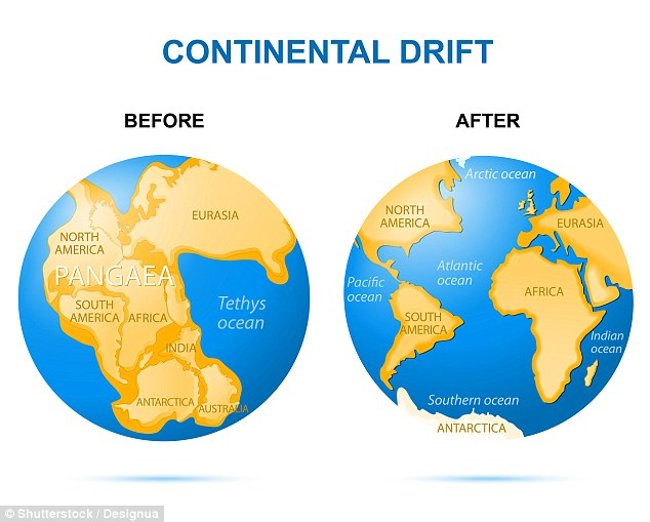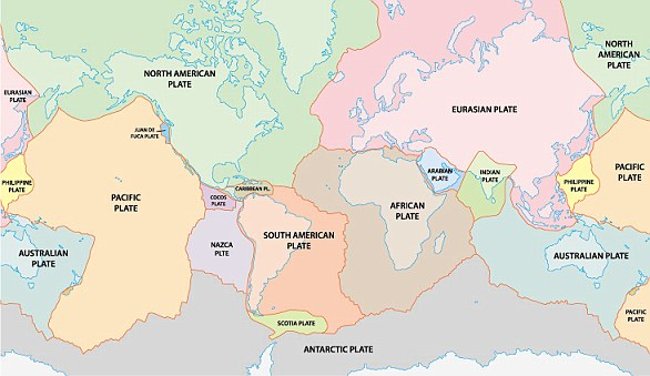Simulation equipment shows that the face of the Earth has a new continent after another 250 million years
Researchers from Yale University and the Ocean Science and Technology Agency - Earth of Japan ( Japan Agency for Marine-Earth Science and Technology ) with the support of simulation devices have shown the appearance Earth after 250 million years.
Researchers have predicted that a new supercontinent - Amasia will form within 250 million years.
According to recent simulations from researchers from Yale University and the Ocean Science and Technology Agency of Japan, " North and South America will get closer together, while Europe Asia will become contiguous, resulting in a new supercontinent - Amasia, due to the consequences of this Caribbean Sea and the Arctic Ocean will disappear.This will happen because of the movements of the ants creating the Earth - the giant plate tectonics of the Earth's crust have moved together and are hundreds of millions of years apart . "
 North and South America will get closer together, while Asia will become a contiguous place, resulting in a new supercontinent - Amasia.As a result of this, the Caribbean Sea and the Arctic Ocean will disappear.
North and South America will get closer together, while Asia will become a contiguous place, resulting in a new supercontinent - Amasia.As a result of this, the Caribbean Sea and the Arctic Ocean will disappear.
Scientists explained: " The world map changes so quickly because of the movement of Earth's tectonic plates. The idea of continental drift was raised by Alfred Wegener, German scientist. first in 1912, when he tried to explain why on the Earth map these continents looked like fragments scattered in a assembled picture ".
Researchers published in Nature, based on the theory called Orthoversion - after a supercontinent broke out, the original continents drifted out but stuck in a North-South band of submerged zone, where an tectonic plate submerges under another tectonic plate.
The earth today is the Pacific Ring of Fire , where the new supercontinent is formed. To test the models, the researchers used paleomagnetic data - studying the traces of past Earth magnetic fields in volcanic rocks, sediments, or diodes. archaeological objects - to study variations in the Earth's rotation for its axis of rotation.
 Based on the theory called Orthoversion - after a supercontinent broke out, the original continents drifted out but were trapped in a North - South band of submerged zone, where a plate of tectonic plates submerged under another construct.
Based on the theory called Orthoversion - after a supercontinent broke out, the original continents drifted out but were trapped in a North - South band of submerged zone, where a plate of tectonic plates submerged under another construct.
These variants are called " True polarity - true polar wander " ( TPW ), caused by changes in the planet's mass distribution, they are Earth's efforts to maintain rotational balance - re-adjustment for millions of years.
By combining data with knowledge of supercontinents affecting Earth's movement, researchers can predict Amasia - the new supercontinent.
Today the Arctic Ocean and the Caribbean Sea will vanish like North and South America while moving north together, leading to a collision between Europe and Asia.
" After the water closes, we continue to study to go to the next supercontinent ," said lead author Dr. Ross Mitchell.
If you believe in the scientific hypothesis, the last continent existed on Earth called Pangea , and it formed about 300 million years ago. Currently, the center of Pangea has Africa. Researchers believe Pangea is the third or fourth supercontinent in Earth's history.
What is tectonic plate?
The tectonic plate comes from the theory of plate tectonics, which is part of the Earth's crust. The Earth's surface can be divided into seven main tectonic plates and many small tectonic plates. Stratigraphic strata ( strata ) indicate the layers of rock formed above the Earth's crust, including stratigraphic units: inter-boundary, gender, system, system, level and zone, corresponding to the geological periods ( interdisciplinary , great, century ), and often contain fossils. Tectonic plate has a much larger thickness than the stratigraphy.
Below is the soft asthenosphere : the area of Trai Dat lies at a depth of 100-200 km below the surface but can expand to a depth of 400km. This is a weak or " soft " area depending on the top layer of the coating. It lies directly below the lithosphere, which is involved in stratigraphic movements and isometric adjustments. Although it is high temperature, high pressure has kept this layer in plastic form and has a relatively low density.
Earth has 15 tectonic plates (pictured above) together to observe the landscape around us today.
Earthquakes often occur at the boundary of tectonic plates, where this tectonic plate lies under other tectonic plates, accelerating or where the tectonic edges form together. Earthquakes rarely occur in the middle of tectonic plates, but they can occur ancient or cracked defects deep below the activation surface. These areas are relatively weak compared to surrounding tectonic plates, which can easily slip and cause an earthquake.
The study was supported by an article published in Geology magazine by Dr. Masaki Yoshida, a geologist from Japan's Ocean-Earth Science and Technology Agency ( JAMSTEC ).
The most recent supercontinent , Pangea ( Greek for "whole land" ) is a supercontinent that once existed in the Mesozoic ( Mesozoic) belonging to the Sinhalese union, before the process passed. It separates it into continents. The name was given by Dr. Alfred Wegener in 1915, formed about 300 million years ago with Africa at its Center.
Supercontinent Pangea began to disintegrate into seven continents today with the creation of the Atlantic Ocean about 100 million years later.
 Researchers believe Pangea is the third or fourth supercontinent in Earth's history.
Researchers believe Pangea is the third or fourth supercontinent in Earth's history.
The previous supercontinent was Rodinia - formed about 1 billion years ago - and Nuna was formed about 1.8 billion years ago. The idea of continental drift was introduced by German scientist Alfred Wegener in 1912, to explain the shape of the countries on Earth in doubt as if puzzle pieces could fit together.
The surface of the Earth is made up of 7 major tectonic plates and some of the main small tectonic plates go around at different speeds from a few millimeters to 2 centimeters per year, equal to the speed of human nail growth. It is the friction caused by slipping tectonics on each other to create earthquakes.
Below is a simulation video about Asmasia supercontinent:
Refer to some more articles:
- The moon has a life expectancy of about 4.51 billion years - bigger than we think and so does life
- China claims to be the first country to bring the probe to the Moon's shadow in 2018
- The interesting fact about the universe is not quite the same as what we thought
Having fun!
You should read it
- Why have scientists found Proxima b - '2nd Earth' until now?
- Decipher the mystery of the extinction that destroyed 96% of marine life
- The discovery of the 'Second Earth' can exist only 4.2 light-years away from Earth
- Is Proxima b our 'neighbor' planet?
- The mystery of the numbers of Proxima b: The 'Second Earth' on the planet may exist life
- How much money does it take to get to Earth 2 and how long does it take?

 The mysterious 9th planet could be a 'free floating' planet
The mysterious 9th planet could be a 'free floating' planet True moon, snow moon and comet will appear together today
True moon, snow moon and comet will appear together today 'Planet Hunters' are looking for signs of extraterrestrial life around nearby stars
'Planet Hunters' are looking for signs of extraterrestrial life around nearby stars SpaceX reversed the plan to launch missiles on Mars by 2020
SpaceX reversed the plan to launch missiles on Mars by 2020 NASA announced concussion: 7 Earth-sized planets could have life
NASA announced concussion: 7 Earth-sized planets could have life How long does it take to get up to 7 life-capable planets - has Trappist-1 been discovered?
How long does it take to get up to 7 life-capable planets - has Trappist-1 been discovered?